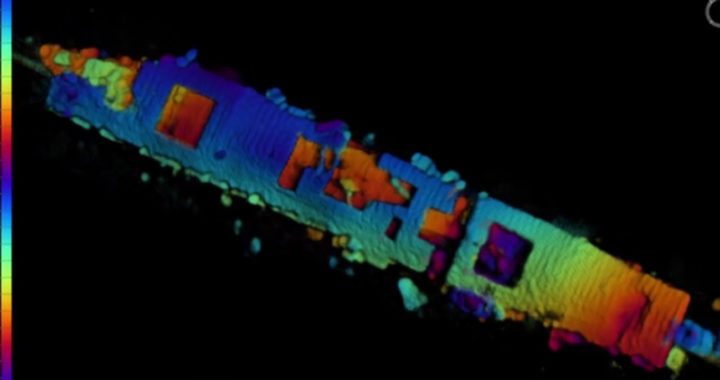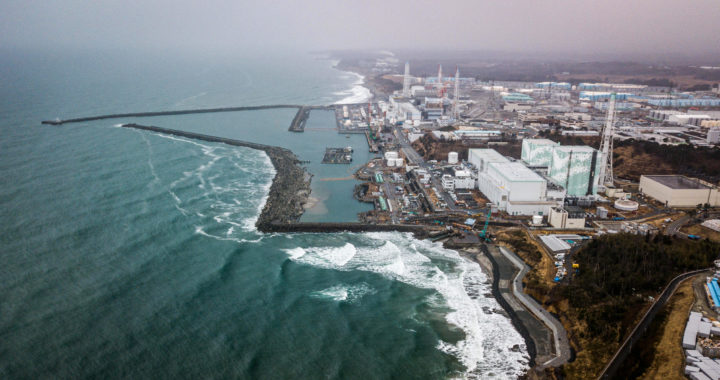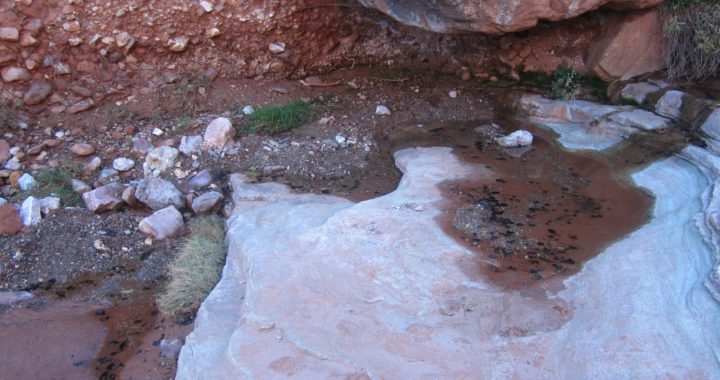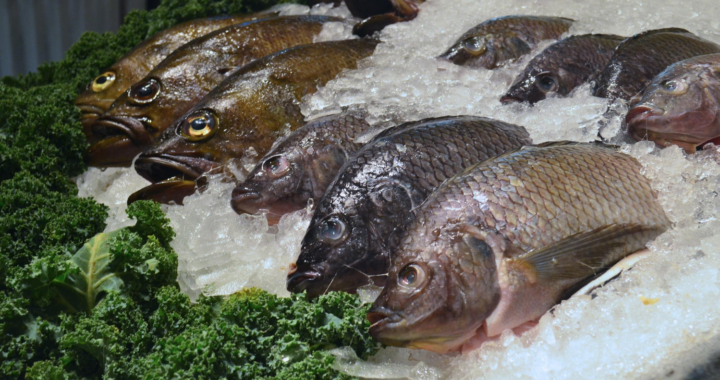Authors: Christopher Figueroa and Jacqueline Garcia under the supervision of Dr. Brian Plimley.
Why the USS Independence?
The USS Independence was a World War II aircraft carrier used as a target vessel for the 1946 atomic bomb test at Bikini Atoll. Following the irradiation, the vessel was used for study in San Francisco to train personnel in radiological decontamination. In 1951, the vessel was retired into the deep sea with 55-gallon drums of low-level nuclear waste. In August 2016, a group of scientists with NOAA embarked on a mission to rediscover the content of the vessel. This involved more than 40 hours of surveying, along with video and photographic documentation, as well as the acquisition of sponge samples. The presence of radioisotopes could indicate environmental contamination from the nuclear history of the USS Independence.
Initial dosimeter readings on the sponge samples upon acquisition did not find readings significantly above ambient levels. However, the dosimeter does not provide energy information, so these initial readings are not sensitive to low levels of radioactive contamination, so additional measurements of sponge samples at our lab in UC Berkeley were necessary. The goal of these measurements is to survey the surrounding area of the USS Independence to determine radiation levels. Levels of contamination indicate whether or not the shipwreck is a threat to marine life and if any efforts should be made to clean up the wreck. These sponge measurements will be compared to previous measurements on other types of samples, such as fish.
What did we look at?
Figure 1: An array of large glass sponges, similar to those collected as samples, covering starboard side of flight deck.
Seven sponge samples were collected from the Independence; collected by the team of scientists and technicians on board the sanctuary vessel R/V Fulmar, using an 18.5-foot-long (5.6 metres) autonomous underwater vehicle (AUV) called Echo Ranger from The Boeing Company. Figure 1 shows a picture of the wreckage, covered in sponges, taken by the AUV, and the locations that the samples that were gathered from are shown in Figure 2. The locations were determined by the proximity to a point on the vessel that had the most damage caused by the weapons test, with NA077-012/13 being directly on top of the site. Sponges were then selected based on how removable they were from their location. Goiter and barrel sponges were acquired for measurement and an additional two sponges (one of each) were collected from Pioneer Canyon to serve as references. The sponges collected from Pioneer Canyon are “clean” since they were not located near any nuclear-related artifacts and can, therefore, serve as a measure of the baseline rate of background radiation for sponges in the area.
|
Figure 2: Approximate locations of the sponge samples on the Independence. Multiple sponges were collected in some of these locations.
|
Figure 3: A processed sponge sample inside the Marinelli Beaker.
|
The sponges collected are then baked in an oven to remove the water content. The water content in the samples will cause attenuation in the emitted gamma radiation and therefore lead to inaccurate readings in the measurements. Once the sponges are fully dried, they are weighed and placed in a Marinelli beaker made specifically for Germanium detectors (Figure 3).
Each sponge sample is placed on a high purity germanium (HPGe) detector located inside a lead cave that consists of lead bricks and copper slabs (for structural support). The purpose of the lead cave is to prevent as much background radiation as possible from entering the HPGe detector while a sample is being measured. The setup of the lead cave is located in Figure 4. Individual measurements are 24 hours in duration.
Figure 4: Sponge sample mounted onto an opened HPGe detector. After the sample is placed, the entrance is covered with lead bricks to reduce background radiation from entering the cave.
Each measurement produces an energy spectra similar to that of Figure 5. Energies below 100 keV are not taken into account since many represent x-rays from the lead shielding. We search for peaks that correspond to radioisotopes that are not naturally occurring. This means finding peaks at energies that correspond to Cs-137 (661 keV) and Co-60 (1173 keV and 1332 keV). Naturally-occurring radioisotopes, such as K-40, Bi-214, and Tl-208, are also evaluated for comparison to other samples. The background energy spectrum for the detector environment is shown in Figure 6. Details of how the full analysis was done are similar to the analysis for our Sample Measurements described in the Technical Details section.
|
Figure 5: Energy spectra for NA077-015 with labeled peaks. Cs-137 was not found in this sample. Results are calculated from the peaks and energies corresponding to Cs-137, Co-60, K-40, Bi-214, and Tl-208.
|
Figure 6: Energy spectra for lab background with peaks not labeled. It must be noted that the Co-60 peaks marked in Figure 5 are also seen as part of this background.
|
Table of Results:
| Sample Type | Location | Sample ID | Sample Size | Cs-137 [Bq/kg] | Co-60 [Bq/kg] | K-40 (natural) [Bq/kg] | Bi-214 (natural) [Bq/kg] | Tl-208 (natural) [Bq/kg] |
|---|---|---|---|---|---|---|---|---|
| Goiter | Independence | NA077-012/13 (Avg.) | 50.8 g | < 0.3 | < 72 | 383 (3) | 6.5 (6) | 1.0 (1) |
| Barrel | Independence | NA077-014 | 65.1 g | < 0.27 | < 37 | 397 (2) | 10.5 (5) | 4.7 (3) |
| Barrel | Independence | NA077-015 | 31.0 g | < 0.52 | < 54 | 141 (3) | 4.2 (1.0) | < 0.68 |
| Barrel | Independence | NA077-016 | 13.1 g | < 1.2 | < 155 | 238 (7) | 18 (2) | < 1.6 |
| Barrel | Independence | NA077-017 | 25.9 g | < 0.63 | < 149 | 113 (4) | 8 (1) | 2.4 (8) |
| Barrel | Independence | NA077-018 | 17.9 g | < 0.89 | < 89 | 169 (5) | < 1.6 | 8.6 (1.2) |
| Barrel | Independence | NA077-019 | 19.8 g | < 0.80 | < 212 | 218 (5) | 4.8 (1.5) | < 1.1 |
| Goiter | Pioneer Canyon | NA0777-024 | 21.9 g | < 0.74 | < 153 | 184 (4) | 11.1 (1.4) | 6.0 (1.0) |
| Goiter | Pioneer Canyon | NA077-033 | 5.9 g | < 2.7 | < 606 | 222 (15) | < 4.9 | < 3.6 |
What did we find?
Table 1 shows there are no significant quantities of Co-60 in any of the sponge samples. (Detection limits indicate what concentrations would have to be in order to produce a significant measurement.) One reason for the lack of Co-60 is the 65 years that have elapsed since the USS Independence was scuttled. The half-life of Co-60 is only 5.3 years and thus any Co-60 present in 1951 has gone through roughly 12 half-lives and decayed away.
Bismuth and thallium concentrations were found to be relatively consistent across all samples with the exception of slightly higher bismuth concentrations in NA077-016. Tl-208 is part of the thorium-232 decay chain whereas Bismuth is part of the uranium-238 decay chain. Both of these isotopes (uranium and thorium) are present in the rocks and soil of the Earth’s crust. Therefore, these decay chain products are most likely present in sediments that have accumulated in the sponge samples.
|
Figure 7: Potassium concentrations for sponges and three other samples. The sponge concentration represents an average and the error bars represent the standard deviation. The error bars for the other three measurements represent the 68% confidence interval. The potassium concentration, with the given interval, is similar to that of the fish samples.
|
Figure 8: Caesium-137 comparison between the sponge average (again, the error bars indicate the standard deviation between the averaged measurements) and three other measurements. The error bars for the other three measurements represent the 68% confidence interval.
|
Potassium was found to have the highest concentrations out of all the measured isotopes. Potassium-40 is a naturally occurring isotope with an isotopic abundance of 0.0117%. Most sponges are filter feeders and tend to gain nutrients from scraps and sediments that sink down to the ocean floor. This includes pieces of fish that are rich in potassium. Comparisons made with the other measurements are shown in Figure 7.
No sponges were found to have Cs-137. Like Co-60, detection limits are listed. For comparison, Figure 8 shows the average Cs-137 detection limit for the seven sponge samples together with the concentrations and detection limits for several of the RadWatch environmental samples. Only the kelp sample, which was measured in a low-background facility where ambient levels are kept to a minimum, has a concentration lower than the detection limit determined from the sponges. This suggests that any concentrations of Cs-137 on the Independence are lower than that of normal measurements from store-bought fish.
What’s the take-away?
No significant amount of Cs-137 was found in any of the sponge samples and the detection limit is not much different than that of the Caesium concentration in a fish from a local market. In addition, no sponge sample contains a significant amount of Co-60. These results demonstrate that the vessel holds no significant threat since the obtained radiation levels are not significantly different from ambient levels. These results will be updated with measurements from a low-background facility to improve on the achievable detection limits, especially for Co-60.
Acknowledgements
The UC Berkeley RadWatch group would like to acknowledge James Delgado, Jan Roletto, Michael Brennan, the crew of the E/V Nautilus, the Oceanic Exploration Trust (OET), the National Oceanic and Atmospheric Administration (NOAA), and the Great Farallones National Marine Sanctuary. (organizations)… for allowing us to participate in this expedition and all of their support for our measurements.




